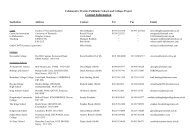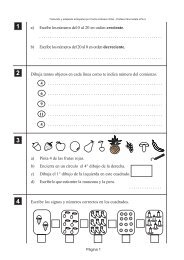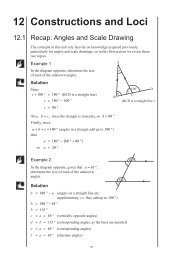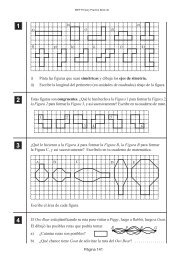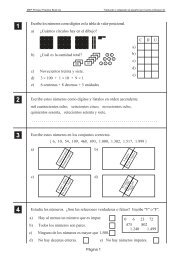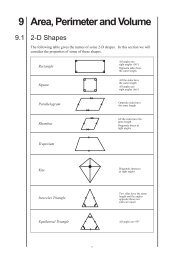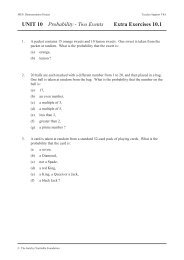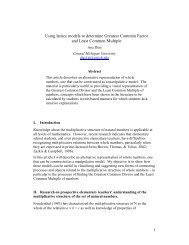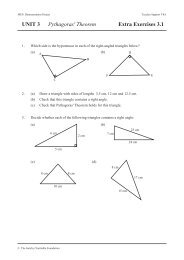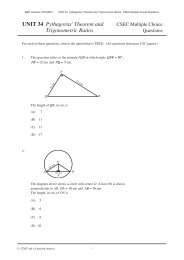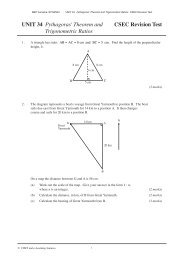It's CAME; We saw; Did it Conquer? – A review of the Cognitive ...
It's CAME; We saw; Did it Conquer? – A review of the Cognitive ...
It's CAME; We saw; Did it Conquer? – A review of the Cognitive ...
You also want an ePaper? Increase the reach of your titles
YUMPU automatically turns print PDFs into web optimized ePapers that Google loves.
score for pupils in <strong>CAME</strong> schools was 67.18 while for those students in non-<strong>CAME</strong><br />
schools <strong>it</strong> was slightly lower at 66.72.<br />
The percentage responses were <strong>the</strong>n calculated for each question and this is shown in<br />
Table 3.1.<br />
The results were subjected to fur<strong>the</strong>r analysis using <strong>the</strong> Mann-Wh<strong>it</strong>ney U-test. It can<br />
be observed from <strong>the</strong> table that 28.3% <strong>of</strong> <strong>CAME</strong> pupils and 17.3% <strong>of</strong> <strong>the</strong> non-<strong>CAME</strong><br />
pupils replied Yes, defin<strong>it</strong>ely or Yes, a b<strong>it</strong> to <strong>the</strong> statement “I like having problems to<br />
solve” and Mann-Wh<strong>it</strong>ney suggests that this is a significant difference (U = 903, p =<br />
0.033).<br />
While no o<strong>the</strong>r statements produced a statistically significant difference between<br />
<strong>CAME</strong> and non-<strong>CAME</strong> respondents <strong>it</strong> is interesting none<strong>the</strong>less to examine <strong>the</strong><br />
results fur<strong>the</strong>r. It can be observed from <strong>the</strong> table that, for example, 37.7% <strong>of</strong> <strong>CAME</strong><br />
pupils replied Yes, defin<strong>it</strong>ely or Yes, a b<strong>it</strong> to <strong>the</strong> statement “I think that problem<br />
solving is fun” as opposed to 28.2% <strong>of</strong> <strong>the</strong> non-<strong>CAME</strong> pupils. In response to <strong>the</strong><br />
statement “I like having difficult work to do”, 15% <strong>of</strong> <strong>CAME</strong> pupils responded<br />
pos<strong>it</strong>ively, that is, responded e<strong>it</strong>her Yes, defin<strong>it</strong>ely, or Yes, a b<strong>it</strong> while 8.7% <strong>of</strong> non-<br />
<strong>CAME</strong> pupils responded pos<strong>it</strong>ively. In <strong>the</strong> same question, 45.3% <strong>of</strong> <strong>CAME</strong> pupils<br />
responded negatively i.e. replied e<strong>it</strong>her Not very true or No, defin<strong>it</strong>ely not while <strong>the</strong><br />
corresponding figure for non-<strong>CAME</strong> pupils was 63%.<br />
The statement “I get anxious when I have to do new work” prompted 18.8% <strong>of</strong><br />
<strong>CAME</strong> pupils and 8.7% <strong>of</strong> non-<strong>CAME</strong> pupils to respond Yes, defin<strong>it</strong>ely or Yes, a b<strong>it</strong>,<br />
and 60.4% <strong>of</strong> <strong>CAME</strong> pupils and 47.9% <strong>of</strong> non-<strong>CAME</strong> pupils to respond e<strong>it</strong>her Not<br />
very true or No, defin<strong>it</strong>ely not.<br />
Considering <strong>the</strong> emphasis in <strong>the</strong> <strong>CAME</strong> project on collaborative problem solving one<br />
might have expected <strong>the</strong>re to be a difference between <strong>CAME</strong> and non-<strong>CAME</strong> pupils<br />
in <strong>the</strong>ir responses to <strong>the</strong> statements “I’m good at discussing things”, “I’m not very<br />
good at solving problems” and “I know how to solve <strong>the</strong> problems I meet”, however<br />
l<strong>it</strong>tle difference between <strong>the</strong> two categories was noted. Among possible explanations<br />
- 13 -



